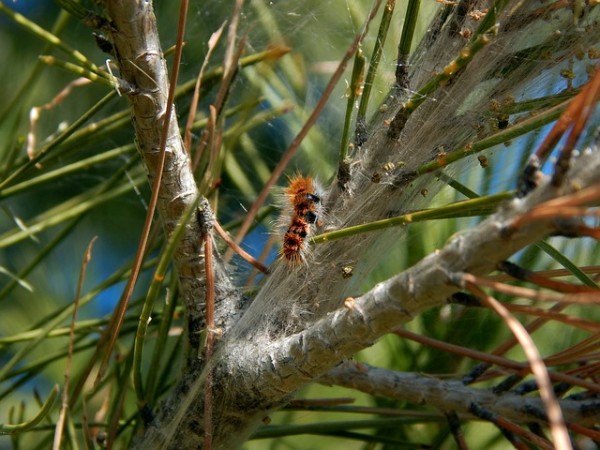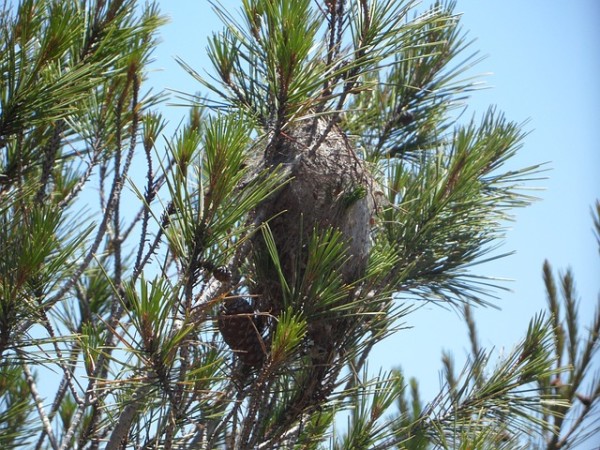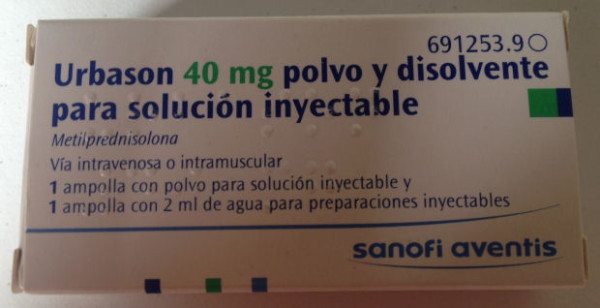Dog owners in Spain beware: processionary caterpillars can kill your pet
April 22, 2015 Leave your thoughts
A couple of weeks ago we went downstairs to check up on our dog and feed her before going to bed and were alarmed to see a big hairy caterpillar just a metre or two away from her.
While our alarm may seem like overreaction, the caterpillar was a “processioner” (processionària in Catalan or procesionaria in Castilian), with poisonous hairs that cause extreme irritation in humans and animals and are known to kill dogs.
I burnt the little bugger as the hairs remain dangerous after death.
What are processionary caterpillars?
The pine processionary caterpillar (Thaumetopoea pityocampa) is the larva of the a type of moth found in Southern Europe, Central Asia and North Africa that nest high in pines (see below) and around March form nose-to-tail processions through the forest in search of pupation sites in the soil (shown here).

During winter the caterpillars will leave their nests at night in search of food, returning at dawn; they eat pine needles and cause massive damage to the host trees, eventually killing them. The nests themselves should be avoided because of number of discarded hairs and in high winds you should avoid walking in areas you know there to be nests.
I’ve never actually seen a procession, but apart from that one caterpillar near our dog have only found them occasionally on the road to the woods. However, there are a large number of nests high in a number of pines near the lake around which we walk.
Why are they so dangerous to dogs?
When threatened on under stress the caterpillars can eject their hairs, which are harpoon-like and have an urticating (irritating) protein that can cause a severe allergic reaction (see this Wikipedia article).
Dogs are at particular risk because they may tread on the caterpillars while out walking and spread the hairs to the mouth trying to get rid of the irritation on their feet, which can cause massive swelling of the tongue and necrosis. Alternatively they may get hairs in their nose by sniffing too closely, or even picking one up in the mouth.
One of my parent’s dogs, a Rhodesian Ridgeback, touched one quite a few years ago and massive swelling occurred almost instantly. My mum gave her a cortisone tablet and that did the trick.
Cats supposedly avoid them on the whole, although I have a friend whose cat did pick one up in its mouth and required several rounds of injections. I don’t know how soon afterwards they went to the vet but I presume they realised very quickly that something was wrong, as swelling occurs within five minutes.
Recognising symptoms
Reported symptoms include heavy salivation but can also include swelling of the tongue (and possibly face) because of an allergic reaction to the poisonous hairs. Reaction to the poison can kill your dog and even if it survives part of the tongue may need to be amputated because of gangrene caused by necrosis. Lovely!
I’m not a vet and have no medical training but my vet’s advice is that if your dog shows these symptoms you should treat it as an emergency.
What to do if your dog is affected
Wash your dog’s mouth with warm water, wearing gloves to ensure you don’t get affected then go to a vet immediately.
Your dog will probably be injected with cortisone to reduce irritation and swelling and depending on the severity of its reaction may be kept overnight for observation or further treatment.
Since we were taking our dog to be vaccinated and are fairly remote, we took the opportunity to ask the vet about treatments we could keep at home in case she does come into contact with one.

He prescribed tablets (2 x 30mg prednisona to be taken a day apart) and an injection (40mg Urbason, which is a methylprednisolone, a type of corticosteroid ) which we now have at home in case our dog needs to be treated, but would plan on taking her to a vet as soon as we could anyway.
What if you find a nest?
If you do see any nests hanging high in the branches of pine (or sometimes cedar, not that I would recognise it!) they need to be treated by experts. Don’t be tempted to deal with any nests in your own garden yourself, as you may end up with a skin irritation caused by spreading the hairs.
According to some information I’ve seen, your local council may be obliged to take care of nests in public areas, but I don’t know if that extends over the whole of Spain. We have not contacted our council yet about the nests here, although we really should do.
Tags: Dogs, Pests, Procesionaria, Processionària, Processionary caterpillars, Processioners

